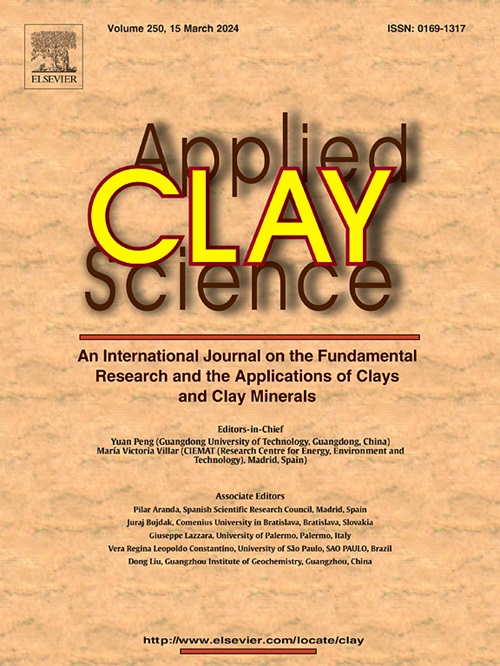Modified natural mineral with a biogenic compound to control microbial growth in waterborne paint
IF 5.3
2区 地球科学
Q2 CHEMISTRY, PHYSICAL
引用次数: 0
Abstract
Hygienic paints are designed to control microbial growth by imparting antimicrobial activity both in-film and in-can. Biogenic compounds like terpenes in essential oils (EOs) have potential antimicrobial properties. Additionally, modified montmorillonites (Mt) show promise as nanoscale carriers for these compounds. This research aimed to obtain a functionalized antimicrobial montmorillonite hybrid to be applied in the formulation of bioactive paints. The biogenic compounds evaluated were the essential oils of white thyme and mint, to be applied for the first time in hygienic coatings. A soybean derivative was used as an organic modifier of the clay mineral. The synthesized hybrids were characterized by Fourier-Transform Infrared (FTIR) spectroscopy, X-ray diffraction (XRD), thermogravimetric analysis (TGA), scanning electron microscopy (SEM), and energy dispersive spectrometer (EDS). Bioassays were carried out against fungal strains including Cladosporium cladosporioides, Chaetomium globosum, and Aspergillus versicolor, as well as bacterial strains such as Staphylococcus aureus and Escherichia coli. White thyme was the EO with the higher antimicrobial activity. Added to this, white thyme oil managed to impart its antimicrobial activity to the synthesized hybrid. The formulated paints with 0.75 concentration of pigment per volume (PVC) efficiently prevented in-can pollution.

含生物化合物的改性天然矿物,用于控制水性涂料中微生物的生长
卫生涂料的设计是通过赋予膜内和罐内的抗菌活性来控制微生物的生长。精油中的萜烯等生物源性化合物具有潜在的抗菌特性。此外,改性蒙脱石(Mt)有望成为这些化合物的纳米级载体。本研究旨在获得一种功能化的抗菌蒙脱土杂合物,用于生物活性涂料的制备。评价的生物源性化合物为白百里香和薄荷精油,首次应用于卫生涂料。采用大豆衍生物作为粘土矿物的有机改性剂。采用傅里叶变换红外光谱(FTIR)、x射线衍射(XRD)、热重分析(TGA)、扫描电镜(SEM)和能谱仪(EDS)对合成的杂化物进行了表征。真菌菌株包括枝孢子枝孢菌、球毛菌和花色曲霉,细菌菌株包括金黄色葡萄球菌和大肠杆菌。白色百里香的抑菌活性较高。此外,白百里香油成功地将其抗菌活性赋予了合成的杂交种。配制的颜料每体积浓度为0.75 (PVC)的涂料有效地防止了罐内污染。
本文章由计算机程序翻译,如有差异,请以英文原文为准。
求助全文
约1分钟内获得全文
求助全文
来源期刊

Applied Clay Science
地学-矿物学
CiteScore
10.30
自引率
10.70%
发文量
289
审稿时长
39 days
期刊介绍:
Applied Clay Science aims to be an international journal attracting high quality scientific papers on clays and clay minerals, including research papers, reviews, and technical notes. The journal covers typical subjects of Fundamental and Applied Clay Science such as:
• Synthesis and purification
• Structural, crystallographic and mineralogical properties of clays and clay minerals
• Thermal properties of clays and clay minerals
• Physico-chemical properties including i) surface and interface properties; ii) thermodynamic properties; iii) mechanical properties
• Interaction with water, with polar and apolar molecules
• Colloidal properties and rheology
• Adsorption, Intercalation, Ionic exchange
• Genesis and deposits of clay minerals
• Geology and geochemistry of clays
• Modification of clays and clay minerals properties by thermal and physical treatments
• Modification by chemical treatments with organic and inorganic molecules(organoclays, pillared clays)
• Modification by biological microorganisms. etc...
 求助内容:
求助内容: 应助结果提醒方式:
应助结果提醒方式:


